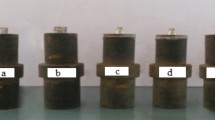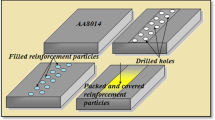Abstract
Aluminum 7075 is an aerospace alloy that has high strength to weight ratio and used most commonly in aeronautic structures. However, low surface properties such as poor wear resistance and surface hardness are the main weaknesses that limit its application in other areas of manufacturing. In the present work an attempt was made to fabricate aluminum based surface nano-composite reinforced with carbon nano tube (CNT) by means of single pass friction stir processing. Firstly, Microstructural evolution, tensile properties, hardness, wear rate and friction coefficient of fabricated surface composite was compared with pure friction stir processed metal and base material. Hereafter, parametric study based on response surface methodology was carried out to find the effect of tool rotary speed, feed rate and amount of MWCNT on tensile strength and wear rate. Optimization based on desirability approach function was also performed to find optimal parameter setting achieving maximum strength and minimum wear rate, simultaneously. The results revealed that the CNT particles significantly homogenized the microstructure of the composite, enhanced tensile properties and hardness and reduced the wear rate and friction coefficient in sliding test. By performing optimization through RSM, it was found that selection of 1250 RPM tool rotary speed, 40 mm/min feed rate and 0.6 g CNT weight caused 20% improvement in tensile strength and wear rate of fabricated composite when compared with base material.












Similar content being viewed by others
References
Tajally M, and Emadoddin E, Mater Des 32 (2011) 1594.
Sharifi E M, Karimzadeh F, and Enayati M H, Mater Des 32 (2011) 3263.
Ramesh C S, Keshavamurthy R, Channabasappa B H, and Ahmed A, Mater Sci Eng A 502 (2009) 99.
Rahimian M, Ehsania N, Parvin N, and Baharvandi H R, J Mater Process Technol 209 (2009) 5387.
Mishra R S, Ma Z Y, and Charit I, Mater Sci Eng A 341 (2003) 307.
Morisada Y, Fujii H, Nagaoka T, and Fukusumi M, Scr Mater 55 (2006) 1067.
Morisada Y, Fujii H, Nagaoka T, and Fukusumi M, Mater Sci Eng A 433 (2006) 50.
Kurt A, Uygur I, and Cete E, J Mater Process Technol 211 (2011) 313.
Sharifitabar M, Sarani A, Khorshahian S, and Afarani M S, Mater Des 32 (2011) 4164.
Gandra J, Miranda R, Vilaca P, Velhinho A, and Teixeira J P, J Mater Process Technol 211 (2011) 1659.
Qu J, Xu H, Feng Z, Frederick D A, An L, and Heinrich H, Wear 271 (2011) 1940.
Raaft M, Mahmoud T S, Zakaria H M, and Khalifa T A, Mater Sci Eng A 528 (2011) 5741.
Dolatkhah A, Golbabaei P, Givi M K B, and Molaiekiya F, Mater Des 37 (2012) 458.
Soleymani S, Zadeh A A, and Alidokht S A, Wear 278–279 (2012) 41.
Moghaddas M A, and Bozorg S F K, Mater Sci Eng A 559 (2013) 187.
Bakshi S R, Lahiri D, and Agarwal A, Int Mater Rev 55 (2010) 41.
Ko´nya Z, Zhu J, Niesz K, Mehn D, and Kiricsi I, Carbon 42 (2004) 2001.
Liu Z Y, Xiao B L, Wang W G, and Ma Z Y, Carbon 62 (2013) 35.
Liu Z Y, Xiao B L, Wang W G, and Ma Z Y, Carbon (2013) (in press).
Hosseini S A, Ranjbar K, Dehmolaei R, and Amrani A R, J Alloys Compd 622 (2015) 725.
Sarmadi H, Kokabi A H, and Seyed Reihani S M, Wear 304 (2013) 1.
Shayan A V, Azar Afza R, and Teimouri R, J Manuf Process (2013). doi:10.1016/j.jmapro.2013.05.001.
George R, Kashyap K T, Rahul R, and Yamdagni S, Scr Mater 53 (2005) 1159.
Olga V F, Scr Mater 38 (1998) 703.
Shafiei Z A, Rashani Bozorg S F, and Zarei H, Mater Sci Eng A 500 (2009) 84.
Author information
Authors and Affiliations
Corresponding author
Rights and permissions
About this article
Cite this article
Ebrahimzad, P., Ghasempar, M. & Balali, M. Friction Stir Processing of Aerospace Aluminum Alloy by Addition of Carbon Nano Tube. Trans Indian Inst Met 70, 2241–2253 (2017). https://doi.org/10.1007/s12666-017-1062-5
Received:
Accepted:
Published:
Issue Date:
DOI: https://doi.org/10.1007/s12666-017-1062-5




